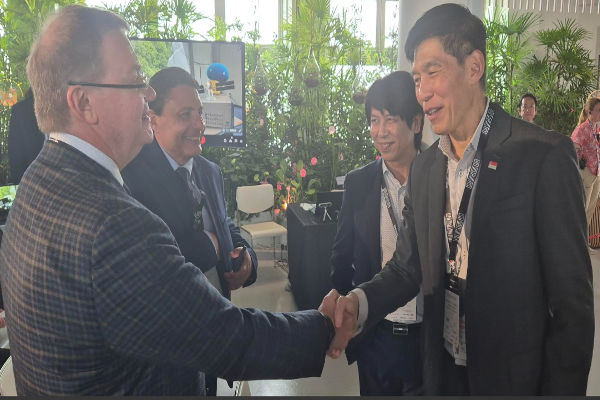Satellite phones and devices are currently the main modes of communication with the rest of the world for remote regions like Antarctica. But that is about to change. Through a unique collaborative research and development effort between industry and academia, regular mobile phones may soon be able to achieve connectivity in such areas.
Five organisations, the Singapore University of Technology and Design (SUTD), SKY Perfect JSAT (JSAT), TMY Technology, Inc. (TMYTEK), Rohde & Schwarz, and VIAVI Solutions (VIAVI), have jointly developed a new 5G non-terrestrial network (NTN) satellite technology to advance mobile connectivity in remote locations. The research team conducted a live demonstration at the World Expo 2025 Singapore Pavilion in Osaka, Japan, showcasing the deployment of an end-to-end cross-country 5G new radio (NR) NTN. The live demonstration was witnessed by Guest-of-Honour, Mr Ong Eng Chuan, Ambassador of the Republic of Singapore to Japan.

At the live demonstration, a 5G signal was transmitted from an end user equipment (UE), such as a communication device, located in Singapore via a satellite antenna, to a geostationary (GEO) satellite operated by JSAT. This signal was then forwarded from the satellite to a ground station in JSAT, Japan, which connects to a 5G base station and 5G core network emulator, demonstrating the feasibility of communications between NTN and terrestrial networks (TN). This is the first such transmission between the two countries.
The live demonstration successfully showed that an existing GEO satellite can reliably support the 5G NR standards as defined by the Third Generation Partnership Project (3GPP), which is a consortium that develops global standards for mobile telecommunications. Although current 5G deployments primarily rely on TN, upcoming 6G networks are expected to be a convergence of both TN and NTN to achieve global coverage and resilient connectivity. Today’s demonstration will lay the foundation for future extensions to medium earth orbit (MEO) and low earth orbit (LEO) satellites, as well as 6G converged TN and NTN.
Said Professor Tony Quek, Director of Singapore’s Future Communications R&D Programme (FCP) and the Head of SUTD’s Information Systems Technology and Design pillar: “As host of the Singapore’s National Future Communications R&D Programme (FCP) and its Future Communications and Connectivity Lab (FCCLab), SUTD is proud to bring together partners JSAT, TMYTEK, Rohde & Schwarz, and VIAVI to collaborate and push the boundaries of 5G technology. Each partner brought a different expertise to the research effort and together, we were able to achieve this breakthrough.
“This partnership also provided SUTD students and researchers with valuable hands-on experience working on cutting edge technologies to solve a real-world problem with experts from around the world. I believe this will enable them to enhance their technical abilities as well as develop essential soft skills for the benefit of their future projects,” he added.
“We are proud to have participated in the world’s first demonstration using our geostationary satellite and 5G NTN Lab at the prestigious World Expo, under the leadership of SUTD. Moving forward, we will continue to contribute to the advancement of telecommunications technology through collaboration and engagement with stakeholders in Singapore and beyond. Additionally, we will provide a highly reliable communication environment through the Universal NTN, an innovative multi-layered communication platform, aiming to establish technologies that enable seamless connectivity between mobile and satellite networks,” said Mr Eiichi Yonekura, Representative Director, President & CEO of SKY Perfect JSAT.
Additionally, this joint collaboration is also among the first in the world to integrate an electronically steered antenna (ESA) for 5G NTN GEO communications. This enables NTN technology to be more suitable for challenging use cases, such as in the maritime and autonomous vehicles industries; or connecting 5G UE to high-speed moving satellites such as LEO or MEO. Mr Su-Wei Chang, Founder and President of TMYTEK said: “At TMYTEK, we are proud to contribute our ESA technology to this pioneering collaboration, demonstrating our expertise in satellite communications and reinforcing TMYTEK as the go-to partner for 5G NTN connectivity.”
Satellite operators, mobile network operators, equipment vendors and end-user application providers need to be able to evaluate the performance of NTN networks and the traffic that runs across them. Rohde & Schwarz and VIAVI have developed an NTN digital twin testbed covering LEO, MEO and GEO, and this was used in the testing and validation of the end-to-end connectivity and performance in the live demonstration.
Dr Sameh Yamany, Chief Technology Officer of VIAVI Solutions said: “At VIAVI, we are committed to enabling the future of global connectivity through innovation and collaboration. This breakthrough in 5G NTN technology marks a pivotal moment—not only proving that seamless mobile communication over satellite is achievable, but also laying the groundwork for resilient, borderless 6G networks. We are proud to contribute our test and validation expertise alongside global partners to turn this vision into reality.”
Mr Samuel Lur, General Manager of Rohde & Schwarz said: “As we unveil the latest in 5G NTN technology at the Osaka Expo, Rohde & Schwarz is proud to highlight our contributions in test and measurement that ensure the integrity and performance of these innovations. This achievement is a result of the collective efforts of our esteemed partners at SUTD and other collaborators. Thank you for your dedication and teamwork in pushing the boundaries of technology.”













